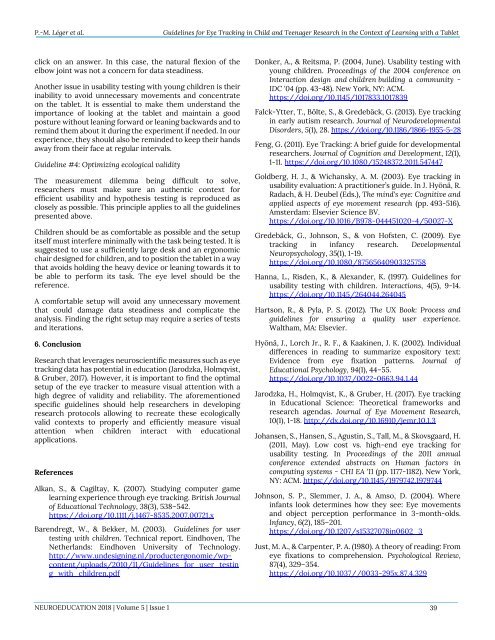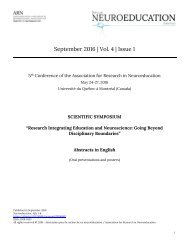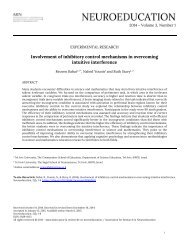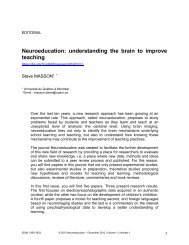Neuroeducation_2018_vol-5_no-1_full
Volume 5, Numéro 1 de la revue scientifique bilingue en libre accès Neuroéducation
Volume 5, Numéro 1 de la revue scientifique bilingue en libre accès Neuroéducation
- No tags were found...
Create successful ePaper yourself
Turn your PDF publications into a flip-book with our unique Google optimized e-Paper software.
P.-M. Léger et al.<br />
Guidelines for Eye Tracking in Child and Teenager Research in the Context of Learning with a Tablet<br />
click on an answer. In this case, the natural flexion of the<br />
elbow joint was <strong>no</strong>t a concern for data steadiness.<br />
A<strong>no</strong>ther issue in usability testing with young children is their<br />
inability to avoid unnecessary movements and concentrate<br />
on the tablet. It is essential to make them understand the<br />
importance of looking at the tablet and maintain a good<br />
posture without leaning forward or leaning backwards and to<br />
remind them about it during the experiment if needed. In our<br />
experience, they should also be reminded to keep their hands<br />
away from their face at regular intervals.<br />
Guideline #4: Optimizing ecological validity<br />
The measurement dilemma being difficult to solve,<br />
researchers must make sure an authentic context for<br />
efficient usability and hypothesis testing is reproduced as<br />
closely as possible. This principle applies to all the guidelines<br />
presented above.<br />
Children should be as comfortable as possible and the setup<br />
itself must interfere minimally with the task being tested. It is<br />
suggested to use a sufficiently large desk and an ergo<strong>no</strong>mic<br />
chair designed for children, and to position the tablet in a way<br />
that avoids holding the heavy device or leaning towards it to<br />
be able to perform its task. The eye level should be the<br />
reference.<br />
A comfortable setup will avoid any unnecessary movement<br />
that could damage data steadiness and complicate the<br />
analysis. Finding the right setup may require a series of tests<br />
and iterations.<br />
6. Conclusion<br />
Research that leverages neuroscientific measures such as eye<br />
tracking data has potential in education (Jarodzka, Holmqvist,<br />
& Gruber, 2017). However, it is important to find the optimal<br />
setup of the eye tracker to measure visual attention with a<br />
high degree of validity and reliability. The aforementioned<br />
specific guidelines should help researchers in developing<br />
research protocols allowing to recreate these ecologically<br />
valid contexts to properly and efficiently measure visual<br />
attention when children interact with educational<br />
applications.<br />
References<br />
Alkan, S., & Cagiltay, K. (2007). Studying computer game<br />
learning experience through eye tracking. British Journal<br />
of Educational Tech<strong>no</strong>logy, 38(3), 538–542.<br />
https://doi.org/10.1111/j.1467-8535.2007.00721.x<br />
Barendregt, W., & Bekker, M. (2003). Guidelines for user<br />
testing with children. Technical report. Eindhoven, The<br />
Netherlands: Eindhoven University of Tech<strong>no</strong>logy.<br />
http://www.undesigning.nl/productergo<strong>no</strong>mie/wpcontent/uploads/2010/11/Guidelines_for_user_testin<br />
g_with_children.pdf<br />
Donker, A., & Reitsma, P. (2004, June). Usability testing with<br />
young children. Proceedings of the 2004 conference on<br />
Interaction design and children building a community -<br />
IDC '04 (pp. 43-48). New York, NY: ACM.<br />
https://doi.org/10.1145/1017833.1017839<br />
Falck-Ytter, T., Bölte, S., & Gredebäck, G. (2013). Eye tracking<br />
in early autism research. Journal of Neurodevelopmental<br />
Disorders, 5(1), 28. https://doi.org/10.1186/1866-1955-5-28<br />
Feng, G. (2011). Eye Tracking: A brief guide for developmental<br />
researchers. Journal of Cognition and Development, 12(1),<br />
1-11. https://doi.org/10.1080/15248372.2011.547447<br />
Goldberg, H. J., & Wichansky, A. M. (2003). Eye tracking in<br />
usability evaluation: A practitioner’s guide. In J. Hyönä, R.<br />
Radach, & H. Deubel (Eds.), The mind's eye: Cognitive and<br />
applied aspects of eye movement research (pp. 493-516).<br />
Amsterdam: Elsevier Science BV.<br />
https://doi.org/10.1016/B978-044451020-4/50027-X<br />
Gredebäck, G., Johnson, S., & von Hofsten, C. (2009). Eye<br />
tracking in infancy research. Developmental<br />
Neuropsychology, 35(1), 1-19.<br />
https://doi.org/10.1080/87565640903325758<br />
Hanna, L., Risden, K., & Alexander, K. (1997). Guidelines for<br />
usability testing with children. Interactions, 4(5), 9-14.<br />
https://doi.org/10.1145/264044.264045<br />
Hartson, R., & Pyla, P. S. (2012). The UX Book: Process and<br />
guidelines for ensuring a quality user experience.<br />
Waltham, MA: Elsevier.<br />
Hyönä, J., Lorch Jr., R. F., & Kaakinen, J. K. (2002). Individual<br />
differences in reading to summarize expository text:<br />
Evidence from eye fixation patterns. Journal of<br />
Educational Psychology, 94(1), 44–55.<br />
https://doi.org/10.1037/0022-0663.94.1.44<br />
Jarodzka, H., Holmqvist, K., & Gruber, H. (2017). Eye tracking<br />
in Educational Science: Theoretical frameworks and<br />
research agendas. Journal of Eye Movement Research,<br />
10(1), 1-18. http://dx.doi.org/10.16910/jemr.10.1.3<br />
Johansen, S., Hansen, S., Agustin, S., Tall, M., & Skovsgaard, H.<br />
(2011, May). Low cost vs. high-end eye tracking for<br />
usability testing. In Proceedings of the 2011 annual<br />
conference extended abstracts on Human factors in<br />
computing systems - CHI EA '11 (pp. 1177-1182). New York,<br />
NY: ACM. https://doi.org/10.1145/1979742.1979744<br />
Johnson, S. P., Slemmer, J. A., & Amso, D. (2004). Where<br />
infants look determines how they see: Eye movements<br />
and object perception performance in 3-month-olds.<br />
Infancy, 6(2), 185–201.<br />
https://doi.org/10.1207/s15327078in0602_3<br />
Just, M. A., & Carpenter, P. A. (1980). A theory of reading: From<br />
eye fixations to comprehension. Psychological Review,<br />
87(4), 329–354.<br />
https://doi.org/10.1037//0033-295x.87.4.329<br />
NEUROEDUCATION <strong>2018</strong> | Volume 5 | Issue 1 39








